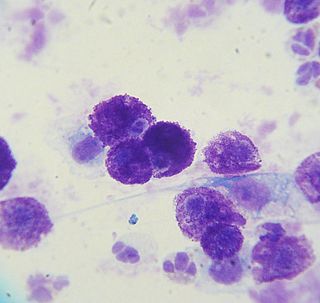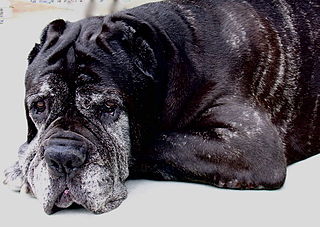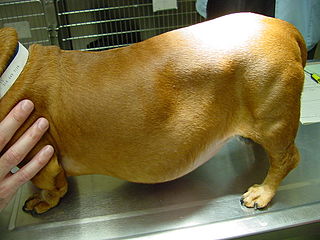
The Siberian Husky is a medium-sized working sled dog breed. The breed belongs to the Spitz genetic family. It is recognizable by its thickly furred double coat, erect triangular ears, and distinctive markings, and is smaller than the similar-looking Alaskan Malamute.

Adenocarcinoma is a type of cancerous tumor that can occur in several parts of the body. It is defined as neoplasia of epithelial tissue that has glandular origin, glandular characteristics, or both. Adenocarcinomas are part of the larger grouping of carcinomas, but are also sometimes called by more precise terms omitting the word, where these exist. Thus invasive ductal carcinoma, the most common form of breast cancer, is adenocarcinoma but does not use the term in its name—however, esophageal adenocarcinoma does to distinguish it from the other common type of esophageal cancer, esophageal squamous cell carcinoma. Several of the most common forms of cancer are adenocarcinomas, and the various sorts of adenocarcinoma vary greatly in all their aspects, so that few useful generalizations can be made about them.

Cryptorchidism, also known as undescended testis, is the failure of one or both testes to descend into the scrotum. The word is from Greek κρυπτός 'hidden' and ὄρχις 'testicle'. It is the most common birth defect of the male genital tract. About 3% of full-term and 30% of premature infant boys are born with at least one undescended testis. However, about 80% of cryptorchid testes descend by the first year of life, making the true incidence of cryptorchidism around 1% overall. Cryptorchidism may develop after infancy, sometimes as late as young adulthood, but that is exceptional.
Neutering, from the Latin neuter, is the removal of a non-human animal's reproductive organ, either all of it or a considerably large part. The male-specific term is castration, while spaying is usually reserved for female animals. Colloquially, both terms are often referred to as fixing. In male horses, castrating is referred to as gelding. An animal that has not been neutered is sometimes referred to as entire or intact.

An adenoma is a benign tumor of epithelial tissue with glandular origin, glandular characteristics, or both. Adenomas can grow from many glandular organs, including the adrenal glands, pituitary gland, thyroid, prostate, and others. Some adenomas grow from epithelial tissue in nonglandular areas but express glandular tissue structure. Although adenomas are benign, they should be treated as pre-cancerous. Over time adenomas may transform to become malignant, at which point they are called adenocarcinomas. Most adenomas do not transform. However, even though benign, they have the potential to cause serious health complications by compressing other structures and by producing large amounts of hormones in an unregulated, non-feedback-dependent manner. Some adenomas are too small to be seen macroscopically but can still cause clinical symptoms.

Dog crossbreeds, sometimes called designer dogs, are dogs which have been intentionally bred from two or more recognized dog breeds. They are not dogs with no purebred ancestors, but are not otherwise recognised as breeds in their own right, and do not necessarily breed true.

A mastocytoma or mast cell tumor is a type of round-cell tumor consisting of mast cells. It is found in humans and many animal species; it also can refer to an accumulation or nodule of mast cells that resembles a tumor.
The anal glands or anal sacs are small glands near the anus in many mammals. They are situated in between the external anal sphincter muscle and internal anal sphincter muscle. In non-human mammals, the secretions of the anal glands contain mostly volatile organic compounds with a strong odor, and they are thus functionally involved in communication. Depending upon the species, they may be involved in territory marking, individual identification, and sexual signalling, as well as defense. Their function in humans is unclear.

The health of dogs is a well studied area in veterinary medicine.

A mammary tumor is a neoplasm originating in the mammary gland. It is a common finding in older female dogs and cats that are not spayed, but they are found in other animals as well. The mammary glands in dogs and cats are associated with their nipples and extend from the underside of the chest to the groin on both sides of the midline. There are many differences between mammary tumors in animals and breast cancer in humans, including tumor type, malignancy, and treatment options. The prevalence in dogs is about three times that of women. In dogs, mammary tumors are the second most common tumor over all and the most common tumor in female dogs with a reported incidence of 3.4%. Multiple studies have documented that spaying female dogs when young greatly decreases their risk of developing mammary neoplasia when aged. Compared with female dogs left intact, those spayed before puberty have 0.5% of the risk, those spayed after one estrous cycle have 8.0% of the risk, and dogs spayed after two estrous cycles have 26.0% of the risk of developing mammary neoplasia later in life. Overall, unspayed female dogs have a seven times greater risk of developing mammary neoplasia than do those that are spayed. While the benefit of spaying decreases with each estrous cycle, some benefit has been demonstrated in female dogs even up to 9 years of age. There is a much lower risk in male dogs and a risk in cats about half that of dogs.

An anal sac adenocarcinoma is an uncommon and aggressive malignant tumor found in dogs that arises from the apocrine glandular tissue of anal sac. The disease exists in cats as well, but is much less common in that species. They are the second most common cancerous cause of hypercalcaemia in dogs, following T-cell lymphoma.

Veterinary surgery is surgery performed on non-human animals by veterinarians, whereby the procedures fall into three broad categories: orthopaedics, soft tissue surgery, and neurosurgery. Advanced surgical procedures such as joint replacement, fracture repair, stabilization of cranial cruciate ligament deficiency, oncologic (cancer) surgery, herniated disc treatment, complicated gastrointestinal or urogenital procedures, kidney transplant, skin grafts, complicated wound management, and minimally invasive procedures are performed by veterinary surgeons. Most general practice veterinarians perform routine surgeries such as neuters and minor mass excisions; some also perform additional procedures.
Canine reproduction is the process of sexual reproduction in domestic dogs, wolves, coyotes and other canine species.

Aging in dogs varies from breed to breed, and affects the dog's health and physical ability. As with humans, advanced years often bring changes in a dog's ability to hear, see, and move about easily. Skin condition, appetite, and energy levels often degrade with geriatric age. Medical conditions such as cancer, kidney failure, arthritis, dementia, and joint conditions, and other signs of old age may appear.
Cancer in cats is the leading cause of death among cats. It is caused by uncontrolled cell growth, and affects a wide range of cell types and organs in the body. Feline cancer initially manifests as a lump or bump on any parts of the body. It rapidly grows in the affected cell, attaches itself to the tissue under the skin in that area, and, depending on the tumour, it can spread to other parts of the body. Although cancer accounts for approximately 32% of deaths in cats over ten years old, it can be successfully treated if diagnosed early.

Cancer is the leading cause of death in dogs. It is estimated that 1 in 3 domestic dogs will develop cancer, which is the same incidence of cancer among humans. Dogs can develop a variety of cancers and most are very similar to those found in humans. Dogs can develop carcinomas of epithelial cells and organs, sarcomas of connective tissues and bones, and lymphomas or leukemias of the circulatory system. Selective breeding of dogs has led certain pure-bred breeds to be at high-risk for specific kinds of cancer.

Salivary gland tumours, also known as mucous gland adenomas or neoplasms, are tumours that form in the tissues of salivary glands. The salivary glands are classified as major or minor. The major salivary glands consist of the parotid, submandibular, and sublingual glands. The minor salivary glands consist of 800 to 1000 small mucus-secreting glands located throughout the lining of the oral cavity. Patients with these types of tumours may be asymptomatic.
Cancer of the nervous system is common in domestic canids, and includes primary neoplasia of the peripheral nervous system, primary neoplasia of the central nervous system and various metastatic cancers. Some of the most common of the central nervous system tumors are several types of primary canine brain tumors. Examples of these include: meningiomas, astrocytomas, glioblastomas, oligodendromas, choroid plexus papillomas, and pituitary adenomas. Breeds predisposed to brain tumors include: Boxer Dog, Pug, English Bull Dog, Boston Terrier, and Golden Retrievers.

Canine Cushing's syndrome - named after Harvey Cushing, who first described disease in humans - or canine hyperadrenocorticism is a common hormonal disease of the domestic dog. It is characterized by high blood levels of glucocorticoids, especially cortisol produced in the adrenal gland (hypercortisolism). The cause is usually tumors of the pituitary gland, which release an excess of the hormone ACTH, which controls the adrenal gland, and thus trigger an overproduction of cortisol. Cushing's syndrome occurs even more frequently due to the administration of synthetic glucocorticoids such as prednisolone or dexamethasone. These are frequently used in veterinary medicine to treat allergys, autoimmune diseases or inflammations and can trigger the same clinical picture with long-term use.














